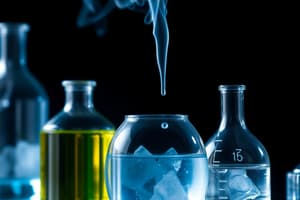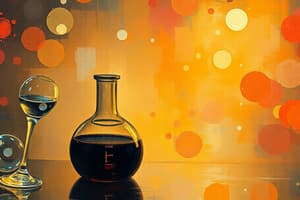Podcast
Questions and Answers
What is the main characteristic of exothermic reactions?
What is the main characteristic of exothermic reactions?
- They release heat to the surroundings. (correct)
- They require heat for the reaction to occur.
- They absorb heat from the surroundings.
- They do not involve any heat changes.
Which factor does NOT affect the rate of a chemical reaction?
Which factor does NOT affect the rate of a chemical reaction?
- Presence of a catalyst
- Color of the reactants (correct)
- Concentration of reactants
- Temperature of the reactants
According to Le Chatelier's principle, how will a system at equilibrium respond to an increase in concentration of a reactant?
According to Le Chatelier's principle, how will a system at equilibrium respond to an increase in concentration of a reactant?
- Shift the equilibrium position to favor product formation. (correct)
- Decrease the total pressure in the system.
- Increase the rate of the reverse reaction.
- Increase the amount of reactants.
How do strong acids differ from weak acids in terms of ionization?
How do strong acids differ from weak acids in terms of ionization?
What does an increase in oxidation state typically indicate in a redox reaction?
What does an increase in oxidation state typically indicate in a redox reaction?
Which statement about organic chemistry is accurate regarding functional groups?
Which statement about organic chemistry is accurate regarding functional groups?
In stoichiometry, what role do mole ratios from balanced equations serve?
In stoichiometry, what role do mole ratios from balanced equations serve?
What does the Ideal Gas Law (PV = nRT) relate?
What does the Ideal Gas Law (PV = nRT) relate?
Flashcards are hidden until you start studying
Study Notes
Key Topics in Chemistry 12
1. Thermochemistry
- Study of heat changes during chemical reactions.
- Endothermic reactions absorb heat; exothermic reactions release heat.
- Enthalpy (ΔH) measures heat content; standard enthalpy of formation (ΔH⁰_f) is crucial for calculations.
2. Kinetics
- The rate of a chemical reaction depends on:
- Concentration of reactants
- Temperature
- Presence of catalysts
- Reaction mechanisms describe the pathway from reactants to products.
3. Equilibrium
- Dynamic state where the rate of the forward reaction equals that of the reverse reaction.
- Le Chatelier's principle states that a system at equilibrium will adjust to counteract changes (concentration, pressure, temperature).
- Equilibrium constant (K) relates concentrations of products and reactants.
4. Acids and Bases
- Arrhenius: Acids produce H⁺; bases produce OH⁻.
- Bronsted-Lowry: Acids donate protons (H⁺); bases accept protons.
- pH scale measures acidity (0-14); pH < 7 is acidic, pH = 7 is neutral, pH > 7 is basic.
- Strong acids/bases ionize completely; weak acids/bases partially ionize.
5. Redox Reactions
- Involve the transfer of electrons between species.
- Oxidation: loss of electrons; Reduction: gain of electrons.
- Oxidation states help track electron transfer; a change in oxidation state indicates a redox reaction.
6. Organic Chemistry
- Study of carbon-containing compounds.
- Functional groups determine the properties and reactions of organic molecules (e.g., alcohols, carboxylic acids).
- Isomerism: structural (different arrangement) and stereoisomerism (different spatial orientation).
7. Stoichiometry
- The calculation of reactants and products in chemical reactions.
- Use mole ratios from balanced equations to convert between grams, moles, and particles.
- Concepts of limiting reactants and percent yield are vital for practical applications.
8. Gas Laws
- Ideal Gas Law: PV = nRT (Pressure, Volume, number of moles, gas constant, Temperature).
- Dalton's Law of Partial Pressures: Total pressure is the sum of individual gas pressures.
- Graham's Law: Rates of effusion/diffusion are inversely related to the square root of molar masses.
9. Solutions
- Homogeneous mixtures of solute and solvent.
- Concentration units: molarity (M), molality (m), and percent composition.
- Colligative properties (e.g., boiling point elevation, freezing point depression) depend on solute quantity.
10. Chemical Bonding
- Types of bonds: ionic (transfer of electrons) and covalent (sharing of electrons).
- Molecular geometry affects physical and chemical properties (VSEPR theory).
- Intermolecular forces (dipole-dipole, hydrogen bonding, London dispersion) influence boiling/melting points.
Important Concepts
- Always balance chemical equations before performing calculations.
- Familiarize with periodic trends (e.g., electronegativity, atomic radius).
- Practice problem-solving with various types of chemical equations and scenarios.
Thermochemistry
- Focuses on heat changes in chemical reactions.
- Endothermic reactions absorb heat, while exothermic reactions release heat.
- Enthalpy (ΔH) quantifies heat content; crucial for thermodynamic calculations.
- Standard enthalpy of formation (ΔH⁰_f) provides a reference point for chemical substances.
Kinetics
- Rate of reactions influenced by concentration, temperature, and catalysts.
- Reaction mechanisms outline the steps occurring from reactants to products.
- Activation energy is key in determining reaction rates.
Equilibrium
- Defined as the state where forward and reverse reaction rates are equal.
- Le Chatelier's principle indicates systems at equilibrium will adjust to external changes in concentration, pressure, or temperature.
- Equilibrium constant (K) quantifies the ratio of products to reactants at equilibrium.
Acids and Bases
- Arrhenius theory: Acids release H⁺ ions; bases release OH⁻ ions in solution.
- Bronsted-Lowry theory: Acids are proton donors; bases are proton acceptors.
- The pH scale ranges from 0 to 14; acidic (< 7), neutral (= 7), and basic (> 7) solutions.
- Strong acids/bases fully dissociate in solution; weak acids/bases partially dissociate.
Redox Reactions
- Characterized by electron transfer between chemical species.
- Oxidation: loss of electrons; Reduction: gain of electrons.
- Oxidation states track the transfer of electrons; changes in these states indicate redox processes.
Organic Chemistry
- Centered on carbon-based compounds and their interactions.
- Functional groups (e.g., hydroxyl, carboxyl) dictate the behavior and properties of organic substances.
- Isomerism includes structural isomers (different connectivity) and stereoisomers (different spatial arrangements).
Stoichiometry
- Involves calculating quantities of reactants and products in reactions.
- Utilizes mole ratios derived from balanced chemical equations for conversions (grams, moles, particles).
- Concepts of limiting reactants help determine maximum product yield and percent yield calculations.
Gas Laws
- Ideal Gas Law equation: PV = nRT relates pressure, volume, moles of gas, gas constant, and temperature.
- Dalton’s Law indicates total pressure equals the sum of partial pressures of each gas in a mixture.
- Graham’s Law states that the effusion or diffusion rate of a gas is inversely proportional to the square root of its molar mass.
Solutions
- Comprise homogeneous mixtures of solute dissolved in solvent.
- Concentration expressed in terms of molarity (M), molality (m), and percent composition.
- Colligative properties, like boiling point elevation and freezing point depression, depend on the number of solute particles in solution.
Chemical Bonding
- Bonds are classified into ionic (electron transfer) and covalent (electron sharing).
- Molecular geometry is explained by VSEPR theory, impacting chemical behavior and interactions.
- Intermolecular forces (dipole-dipole, hydrogen bonding, London dispersion) significantly influence physical state properties such as boiling and melting points.
Important Concepts
- Balance chemical equations prior to any calculations for accuracy.
- Understand periodic trends including electronegativity and atomic radius for predicting element behavior.
- Engage in consistent practice with diverse chemical equations and scenarios for mastery.
Studying That Suits You
Use AI to generate personalized quizzes and flashcards to suit your learning preferences.




